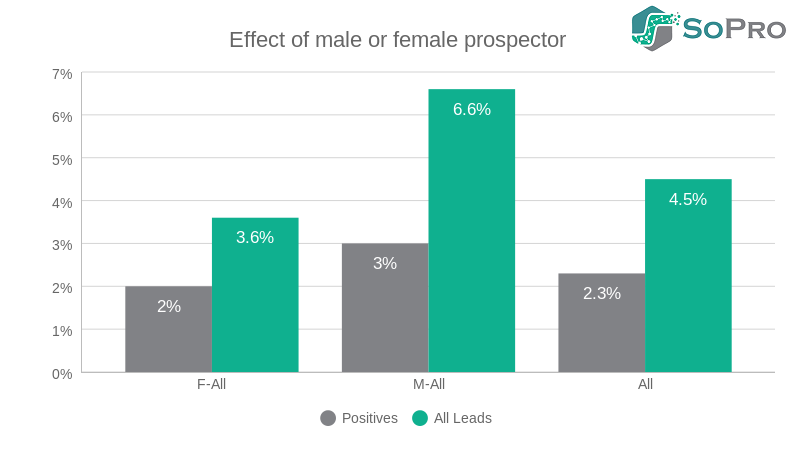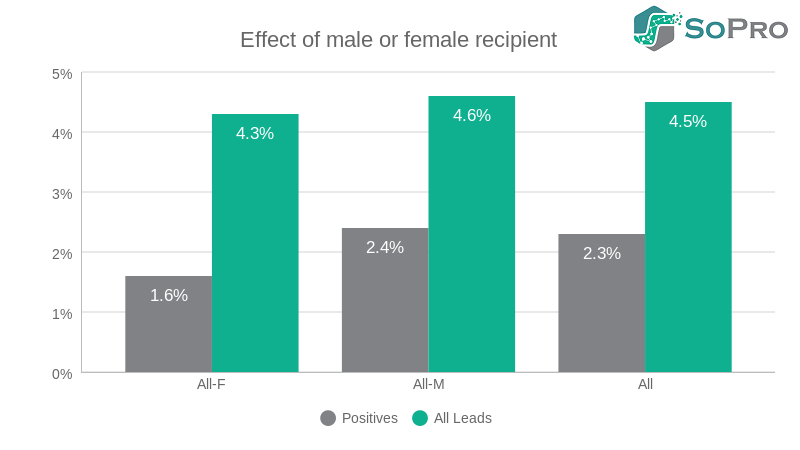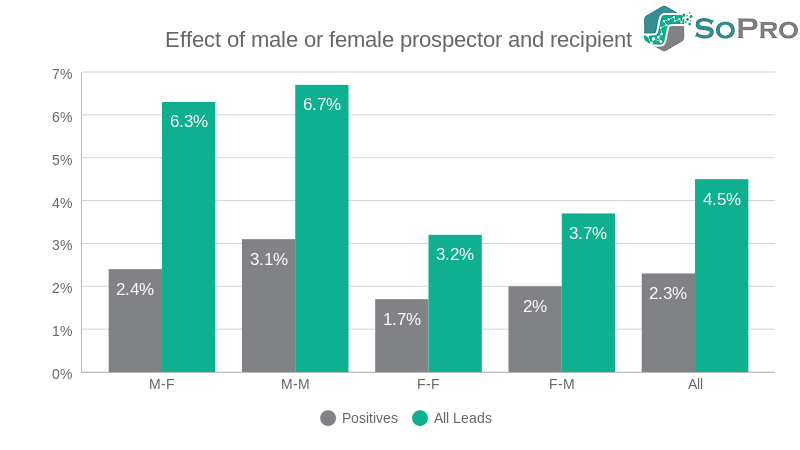What effect does gender have on lead generation?

We’ve covered a good deal of ground in our Sopro Insight series, digging up nuggets of data that reveal the effects of everything from company size to time of day when it comes to a prospecting campaign. Now it’s time to tackle lead generation when looked at through the prism of gender.
Specifically, we are going to study the initial generation of leads through email – and see what differences there are when the sender’s and the recipient’s gender are taken into account.
- Does a female sender generate more leads than a male?
- Is a male to male approach more likely to succeed than a male to female?
- Are women more likely to respond positively than men?
The data will be revealed in just a moment – but first a little bit of housekeeping.
Gender on the agenda
As a major demographic factor, there is relatively little written about the effect of gender on lead generation. If you know of any useful studies please let us know – we’d love to follow up on this.
There are a few articles comparing things like email open rates and times (see this report from the US, for example) but we’ve drawn a bit of a blank finding any useful recent data that looks at gender and prospecting success.
Fairly typical is this:
“While age, gender, geography and demographics are valuable segments, the secret sauce lies in the behaviour-driven segmentation. That is, connecting with individuals in a relevant and valuable way, at the right time in the buyer journey.”
But, of course, this is considering leads in the middle of the funnel. What we are interested in is whether gender can affect the generation of leads – and not their conversion.
Gender and prospecting
Let’s be clear about the sort of prospecting emails we are analysing.
- These mails are ‘introductions’ that seek to secure a meeting or a phone call to discuss a B2B product or service.
- Their sole aim is to generate leads.
- They are carefully targeted, brief (around 200 words) and absolutely to the point.
And they work: our lead rate is around 4%.
So, now let’s see what happens if you segment our success by gender.
Does gender affect lead rates?
We’ve taken around 10,000 mails from recent campaigns and crunched the data to see how gender affects it. The campaigns were chosen at random, but they represent a good cross-section of industries.
Here are the headline results across all emails: this represents the benchmark against which we can chart the gender bias of prospecting.
A ‘Positive’ response is an agreement to take a call or meet. These are included alongside softer responses, such as referrals and deferred interest, in the ‘All Leads’ category.
Let’s now look at what difference it makes if the prospector is male or female – regardless of the gender of the recipient.

It’s clear in the data that a male prospector has more chance of success.
The chances of a male sender securing a positive response or a lead are, respectively, 50% and 83% better than a female sender – a marked difference.
Looking at the data from another angle we can see what effect there is according to the gender of the recipient. Or, more bluntly, are women more likely to become leads than men?

As can be seen – there’s barely any significant variance at all. Which just serves to highlight the differences we saw when looking at the gender of the prospector.
To try and dig a little deeper, looking at whether there were discrepancies between men sending to women and women to women etc

Interestingly, female to female performs worse than female to male – but this same gender bias is reversed with men, where male to male performs marginally better.
In fact, our data suggests that a male to male email, compared to a female to female, will more than double your prospects engaged.
e-Male?
The data clearly suggest that the biggest impact gender has on prospecting is whether the sender is male or female.
Factors such as who receives the email, or whether it was sent to the same gender, did not greatly alter the outcome.
Many more leads were generated when the sender’s gender was male. In terms of hard leads, a male sender generated 54% more than women. In terms of all leads (including referrals and deferred interest), they generated 83% more.
We were surprised by the findings and, frankly, a little disappointed by the potential wider implications…




Share